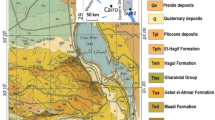Abstract
In this work, we used seismic refraction and magnetic methods to find the extension of a known subsurface fault and delineate for the existence of many others. Combination of both seismic refraction and magnetic method give a better subsurface view, where both seismic and magnetic methods can detect fault locations; however, fault thrown and subsurface layering will be better detected by seismic method, while magnetic method will provide a better lateral view of the faulting system in the study area. Seismic refraction shows that at least two fault plans exist in the subsurface; magnetic results supported seismic results and suggested the existence of several small fault plans in the study area.
الملخص
في هذه الدراسة تم استخدام طريقتي السيزمية الانكسارية و المغناطيسية الأرضية لإيجاد و تحديد امتداد احد الفوالق الطبيعية الموجوده تحت سطح الأرض و محاولة تحديد فوالق أخري إن وجدت. مزيج من كلا من طريقتي السيزمية الانكسارية و المغناطيسية الأرضية تعطي صورة أفضل و أوضح لما تحت السطح . حيث أنه يمكن لكلا من الطريقتين تحديد أماكن الصدوع و الفوالق التحت سطحية . يمكن تحديد رمية الفالق بطريقة أكثر وضوحا" و سهولة باستخدام الطريقة السيزمية الانكسارية . بينما تقوم الطريقة المغناطيسية الأرضية بتوفير صورة أفضل عن التوزيع الأفقي للفوالق الممكن تواجدها تحت سطحيا" . و لقد أوضحت الدراسة السيزمية الانكسارية وجود على الأقل وجود فالقين تحت سطحيين في منطقة الدراسة و قد عضتت قياسات المغناطيسية الأرضية نتائج القياسات السيزمية الانكسارية كما ارجحت وجود مجموعة أخري من الفوالق الطبيعية التي يمكن تواجدها في منطقة الدراسة









Similar content being viewed by others
References
Aboud E (2005) Development in magnetic data interpretation technique using Euler deconvolution and analytic signal methods, PhD thesis. Kyushu Univ, Japan
Barbosa VCF, Silva JBC, Mederios WE (1999) Stability analysis and improvement of structure index estimation in Euler deconvolution. Geophysics 64:48–60
Bown MT, Mary KJ (1988) Geology and paleoenvironment of the Oligocene Jebel Qatrani Formation and adjacent rocks, Fayum Depression, Egypt. Geol Surv Prof Pap 1452:60
Bridle R (2006) Plus/Minus refraction method applied to 3D block. SEG Expanded Abstracts 25, 1421. from magnetic data:. Geophysics 47:31–37
Hagedoorn JG (1958) The plus-minus method of interpreting seismic refraction sections. 15th meeting of European Association of Exploration Geophysicists, London
Hanafy ShM (2005) Seismic refraction interpretation using finite difference method. SAGEEP 2005:1012–1024
Hawkins LV (1961) The reciprocal method of routine shallow seismic refraction investigations. Geophysics 26(6):806–819
Hodgkinson J, Brown RJ (2005) Refraction across an angular unconformity between nonparallel TI media. Geophysics 70:D19
Khalil MH, Hanafy Sh M (2008) Engineering applications of geophysics: A field example at Wadi Wardan, northeast Gulf of Suez, Sinai, Egypt. J appl geophys 65:132–141
Khalil MH, Hanafy ShM, Gamal MA (2008) Preliminary seismic hazard assessment, shallow seismic refraction and resistivity sounding studies for future urban planning at the Gebel Umm Baraqa area, Egypt. J Of Geophysical Engineering 5:371–386
Reid AB, Allsop JM, Granser H, Millett AJ, Somerton IW (1990) Magnetic interpretation in three dimensions using Euler Deconvolution. Geophysics 55:80–90
Said, R., 1962, The Geology of Egypt, El Sevier Publishing Company, p. 104
Shallaly N (1992) Geology and tectonic setting of the basalts and associated rocks, El Fayum area. M.SC. Cairo University, Western Desert, Egypt
Thompson DT (1982) EULDPH: A new technique for making computer-assisted depth. Geophysics 47:31. doi:10.1190/1.1441278
Verduzco B (2004) New insights into magnetic derivatives for structural mapping. Leading Edge, The 23:116–119
Yilmaz O, Eser M, Berilgen M (2006) Seismic, geotechnical, and earthquake engineering site characterization. SEG Expanded Abstracts 25:1401
Author information
Authors and Affiliations
Corresponding author
Rights and permissions
About this article
Cite this article
Hanafy, S.M., Aboud, E. & Mesbah, H.S.A. Detection of subsurface faults with seismic and magnetic methods. Arab J Geosci 5, 1163–1172 (2012). https://doi.org/10.1007/s12517-010-0255-6
Received:
Accepted:
Published:
Issue Date:
DOI: https://doi.org/10.1007/s12517-010-0255-6




